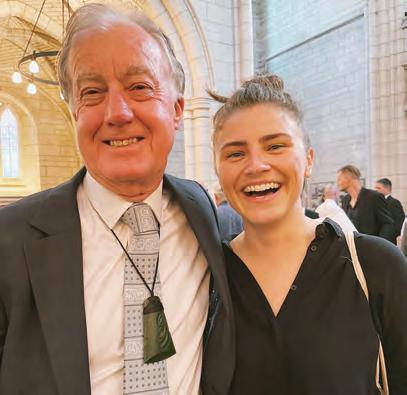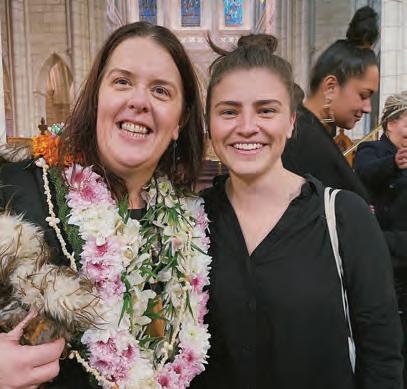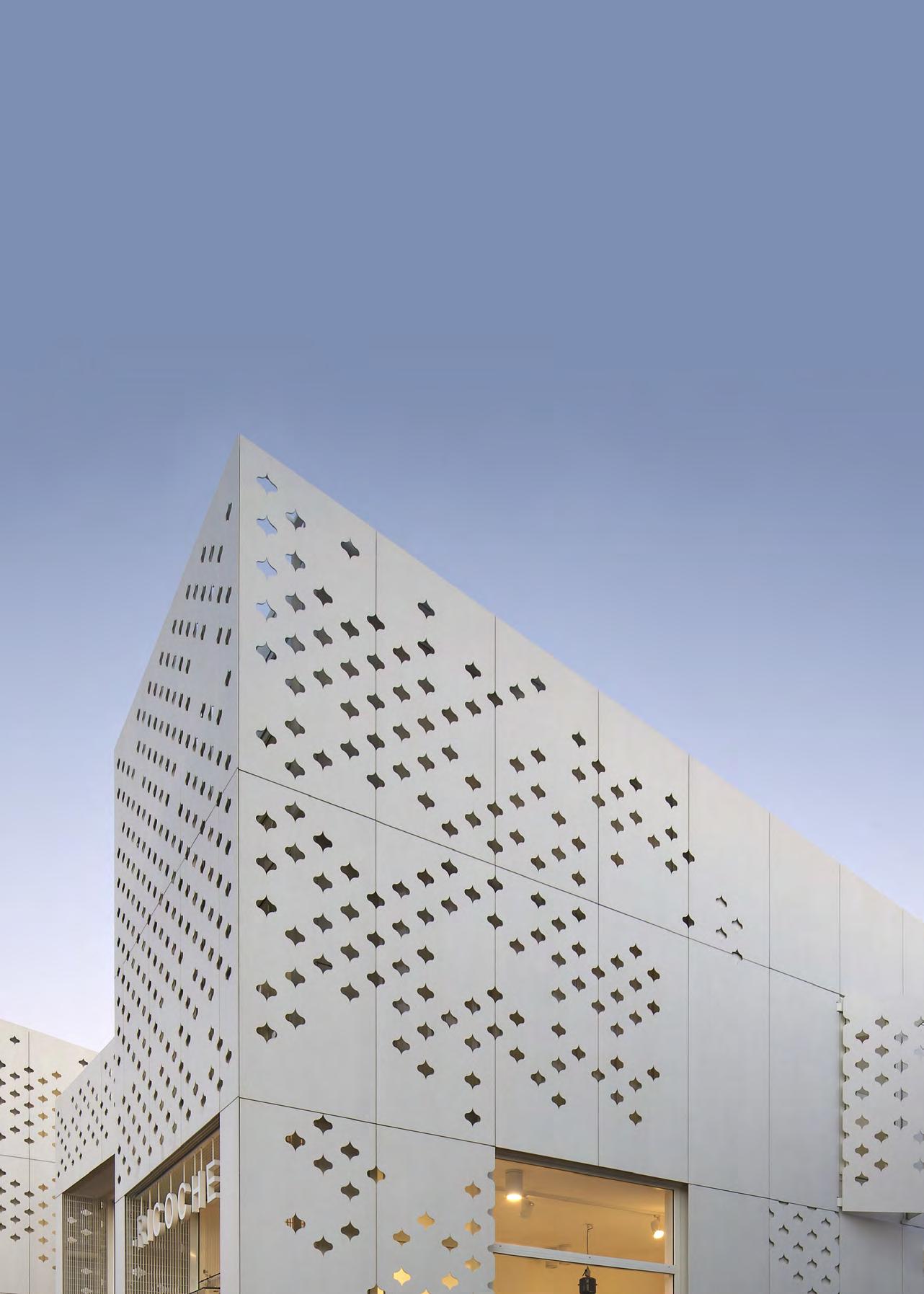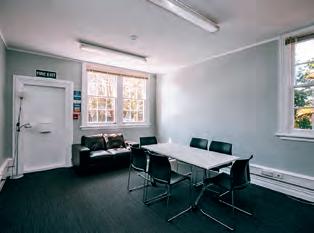
23 minute read
CHLÖE SWARBRICK: MP AUCKLAND CENTRAL
from PONSONBY NEWS '21
While the temperature drops and Auckland’s infamous patchy downpours become all the more frequent, May also brings temptation to keep getting outdoors: it’s NZ International Comedy Festival and New Zealand Music Month.
While I’ll reserve comment on whether politics is sometimes a bit of a joke, I can at the very least promise you’ll be able to find a bunch of local musicians playing at our official Auckland Central office launch party at Karangahape Road’s First Thursdays this coming Thursday 6th May!
After we won the privilege of representing our Auckland Central electorate, I spent time talking to a number of politicians, electorate staffers and officials about how best to establish an office that truly served our community. To my surprise, many spoke of the importance of having a space that was out-the-way. Initially intrigued about this being a budgetary constraint that a little DIY and creative thinking could overcome, it became clear that in fact, we were actually being warned that visibility generates more work, more walk-ins, more community engagement.
I’d always thought that was the entire point of the job. For that reason, you’ll find our electorate office on Karangahape Road, between Queen Street and Symonds Street. A mere stones’ throw from Ponsonby, we’re right in the thick of so many of the things that make our city what it is: the good, the bad and the ugly. It’s the kind of approach I hope we become known for over the next three years of service: celebrating local innovators, businesses and creators, while confronting head-on - literally staying street level with - the problems and growing pains in our communities.
While my office can play the connector role in bringing people together, advocating local solutions through the privilege of this platform, it’s important to acknowledge that change, for better or worse, is rarely an individual feat.
Please get in touch if we can help you with local issues
09 378 4810 chloe.swarbrick@parliament.govt.nz
Auckland Council - 09 301 0101 COVID-19 advice from Healthline - 0800 358 5453 Healthline: General health advice - 0800 611 116 Inland Revenue - 0800 257 777 Ministry of Social Development - 0800 559 009 Need to talk? Free counselling helpline - Phone or text 1737
Chlöe Swarbrick
MP for Auckland Central

Chris Farrelly & Chlöe Swarbrick

Helen Robinson & Chlöe Swarbrick
That said, leadership in all its forms is critical in plotting a pathway forward.
I want to take a moment to acknowledge the incredible service of our outgoing Auckland City Missioner, Chris Farrelly, who I’ve known well since walking into his office as a plucky and precocious twenty-something Mayoral candidate back in 2016, wanting to know how we ended homelessness once and for all. In Chris’ five year tenure, we’ve seen a shifting of heaven and earth to bring about the near completion of Homeground, the largest project in the Missions’ history, to provide beds, food, treatment and advocacy for those who’ve fallen through the cracks.
Picking up the reigns is Helen Robinson, whom I’ve been privileged to know for the past year or so in her last role as the Mission’s Social Services General Manager. I’ve always admired her honesty and openness in the challenges we face, but more than that, the solutions in championing the dignity of all people to live a good, contributing life. Here’s to the mahi ahead.
As the opening of our Trans-Tasman bubble allows us to reconnect with Aussie friends and whanau, we’ve not only got an awesome opportunity to reflect on where we’ve been over the ‘unprecedented’ last year, but where we want to go, and who we want to be. The Team of Five Million have, so far, knocked Covid-19 out the park. This month, we can celebrate coming together to support local talent, solve local problems (drop me a line if you’ve any ideas or insights!) and continue building an ever-stronger community along the way.
Chlöe Swarbrick’s Auckland Central Office opening party is 7pm, Thursday 6 May, 74-76 Karangahape Road. The evening will be based primarily in their next-door neighbour’s, Monster Valley, as a well-equipped location for live music, equipped with a small craft beer bar. All welcome. (CHLÖE SWARBRICK) PN
JOHN ELLIOTT: THE EVILS OF GROSS INEQUALITY IN NEW ZEALAND
Back in the 1950s we used to say New Zealand was a very egalitarian country; and it was.
Sure there were wealthy people - industrialists and business people like Myers, Kerridge, Caughey, Yates, Dove-Myer Robinson. There were landed gentry like Elworthy, Kelt, Ormond. And there were flash cars. Robbie and Rainton Hastie, of strip club fame, both drove Rolls Royces.
There were also poverty pockets of run down, barely livable houses (especially rural Maori), and a growing number of urban poor.
But there was nothing like the income gap now existing in Aotearoa, nor any of the ostentatious flaunting of wealth we see today. ‘His and Hers’ Ferraris, Lamborginis, Aston Martins galore, and Mercedes winning car of the year in New Zealand - at $150,000 a disgrace.
No, it’s not jealousy, nor tall poppy syndrome, it’s concern for the wider New Zealand society, increasingly divided, anxious, depressed, and angry.
Increasing affluence is not making people happier. As Australian public professional Clive Hamilton has said, “Westerners are four or five times wealthier than they were 50 years ago, but they are no happier.”
Between 1985 and 2000 under Douglas and then Richardson, both rampant neo-liberals after the style of Thatcher and Reagan, the rich got richer and the poor got poorer in God’s own country. If you read The Spirit Level, by Wilkinson and Pickett, you see how New Zealand fairs badly in social statistics like prison incarceration, child mortality, teenage pregnancies and youth suicides alongside the inequality.
Recently I have noted an increase in gated communities. This is the beginning of a ‘them and us’ mentality. It could end in revolution - an extreme proposition, but one not unknown in our difficult modern world.
Much of what appears ‘natural’ today dates only from the 1980s - the obsession with wealth creation, the cult of privatisation and the private sector, the growing disparities of rich and poor. The rhetoric that goes with this includes uncritical admiration of unfettered markets, disdain for the public sector and the delusion of endless growth. Economists like Joseph Stiglitz, former world bank economist, and Thomas Picketty, writer of Capital in the Twenty-First Century, have warned of the gross inequality. Stiglitz calls for both pre and post income redistribution through taxation, while Picketty postulates a depressing equation which embeds inequality in a capitalist society, where R is the rate of return on capital and G is the rate of growth in the economy.
Most economists are not calling for socialism or total state control. They are calling for a better balance between private enterprise and state control.
Can anything really be done to produce a fairer economy for New Zealanders, or is it too late? I think there are three plausible possibilities.
The first is that the 99% will rise up and overthrow the 1%. The numbers taking to the streets during the so-called Arab Spring were impressive. Regimes in Egypt, Tunisia, and Libya were overthrown.
The second possibility is that the 1% could begin to understand that the status quo is not in their best interests (hiding behind gated communities, frightened of violence and theft, knowing the system is unfair). They may just start to realise that it is in their interests to have a fairer and more just society.
The third scenario would see the diminishing middle classes realise that they have been kidding themselves when they think that their interests are the same as the interests of the 1%. This is what Marx called ‘false consciousness’.
Most tellingly, as Sir Edmund Thomas (retired judge of the New Zealand Court of Appeal) said in his Bruce Jesson memorial lecture several years ago, “New Zealand will never again be a fair and just society until we rid ourselves of the last vestiges of neo-liberalism.”
We must act now before we lose our planet, and our democratic way of life, and this Labour government may be our best chance. (JOHN ELLIOTT) PN

With the Covid-19 vaccination soon to be offered to the ‘mature’ age group that makes up most of the U3A membership, it was timely that Ponsonby U3A be given the talk, “Vaccines yesterday and today” by its own eminent scientist member Dr Margot Skinner.
It was timely for two reasons; first the anti-vax lobby against vaccination; second there have been a number of questions raised about the Covid-19 vaccines and their effectiveness and safety.
Previously the majority of the population has not questioned the use of vaccinations for the elimination of measles, meningitis, shingles, pneumonia, tetanus, whooping cough, diphtheria, tuberculosis and influenza. Generally, the population saw good reason for having these – but are there reasons with the Covid-19 vaccines that we should reconsider? The April guest speaker Anna Willison entitled her talk, “A day in the life of a fishery officer”. It was, in fact, much more than that. Anna is a senior fishery officer in the North Harbour team for the Ministry for Primary Industries. She looks after the area north of the Auckland Harbour Bridge, Kaipara Harbour, Waitemata and Manukau and deals with fisheries compliance and compliance and governance.
It would be unlikely after Dr Skinner’s talk that some, if any, of us would turn down the opportunity for protection from the Covid-19 pandemic that is currently sweeping the world. The past year has been unlike any we have experienced in our time – and how lucky we are to live in New Zealand, seemingly safer than almost any other country because of the policies that have been enacted here and our physical isolation from the rest of the world.
Dr Skinner’s talk covered a brief outline of the body’s immune system; the principles of vaccination; herd immunity; different types of conventional vaccine; new types of vaccine for Covid-19; results of a Pfizer/BioNtech Clinical Trial; and a summary of other Covid-19 vaccines.
Herd immunity was discussed. Once vaccinated we are likely to be protected against the targeted disease. However, some people can’t or won’t be vaccinated, but if enough people are vaccinated then the unvaccinated are likely to be protected against the targeted disease. The question is what percentage of people need to be vaccinated against Covid-19 to achieve herd immunity?
“We don’t know that yet,” said Dr Skinner, “But it will likely be between 95 percent and 70 percent based on other vaccines.” She has been a fishery officer for 11 years, having previously been a police woman in the Victoria Police. Her special interest is international fisheries and interagency work. “I love getting out with the navy, air force and police. And I also love that here in Auckland anyone can fish and gather seafood. I’m passionate about looking after our ocean and coastline. I think education is the key to sustainable harvesting. My office is the great outdoors and on a daily basis I am at the beaches or on the water as kaitiaki for our beautiful resource.”
Ponsonby U3A meets on the second Friday morning of the month. As well as two speakers there are reports from special interest groups. Guests are welcome to attend to see if U3A is for them, but are first asked to telephone Philippa Tait on T: 027 452 3108.
The guest speaker for the May meeting will be Wayne Brittenden talking about his life as a foreign correspondent. The 10-minute speaker will be U3A member Colin Harvey. PN
NEXT MEETING: Friday 14 May at Herne Bay Petanque Club, Salisbury Reserve, Salisbury St, Herne Bay. Tea from 9.30am, meeting commences at 10am.
ENQUIRIES: Philippa Tait, President, Ponsonby U3A, T: 0274 523 108, www.u3a.nz
LET’S REMOVE THE DEADWOOD The ‘independent experts’ recommended to remove the deadwood from Western Springs Forest. That includes 12 dead trees and branches from 40 others. Instead, a huge road of mud and gravel has scarred the centre of the forest and mature native trees have been slaughtered causing a gaping wound on this ecosystem.
Maybe the ‘deadwood’ needs to be removed from Auckland Council and Community Facilities (CF) instead! These are the people who are being careless with ratepayers’ funds that would be better spent on Ponsonby Park or repairing the Leys Institute building.
New Zealand Royal Spoonbills screeched at the boom and crash of a 40 metre high canopy tree being felled. (Video on FB.) These birds were on the endangered list a few years ago and now their colony has grown to the extent that teenagers visit the lake on a daily basis, probably to start a new colony, or at least to avoid their parents.
Another rare specimen was found in the forest recently, a politician with integrity who cares about community engagement enough to sit on a digger and be arrested. Maybe a few of the ancient specimens just warming seats awaiting a knighthood need to fly off instead!
One of the many security guards employed by CF, believed she saw four bats around midnight on Sunday 11 April but CF are refusing to even talk to her, let alone investigate. She may have been mistaken but that is far less damaging than destroying the habitat of an endangered indigenous mammal when Aotearoa has so few mammals. Gael Baldock, Community Advocate
HISTORICAL ENQUIRY I am researching James Mason (1833 -1915) and William Mason (1840 - 1905), both of whom were commercial nurserymen. William Mason was a significant landowner in Ponsonby between 1875 - 1905. Apparently, either of them are said to have built the original Ponsonby Club Hotel in the early 1870s. At this stage I am very uneasy with the correctness of that statement - hence I would be most grateful for any record/information you have on this topic; or, if you could give any contacts who may be able to assist with my enquiry. Brian Byrne, Ponsonby
WAITEMAT A LOCAL BOARD One of the underlying concerns that members of the public have of the Waitemata Local Board is the lack of meaningful community engagement. The members community engagement could be significantly enhanced if it moved the venue for its Board meetings to a larger venue (so that everyone attending can fit in) and provide proper video facilities so that their deliberations can be viewed live and then uploaded to become a matter of public record. As an added bonus, they could invite the public to join them at afternoon tea so that there was some real face-to-face engagement. Anyone for tea? Keith McConnell, keith@keithforwaitemata.com

JOHN ELLIOTT: WHAT ANGERS LISA PRAGER ABOUT LOCAL GOVERNMENT?
Local activist Lisa Prager has been a thorn in Auckland government’s side for a long time.
We asked her what she thinks of the current situation, and what it is that has gone so wrong.
Lisa Prager told us that Mayor Phil Goff is the most dangerous and destructive mayor we have ever had. “He is a bully, and extremely manipulative. Goff leads a council which is not open and transparent,” she added.
On the one issue of trees in Auckland, Prager told us Goff has overseen more trees destroyed than any other mayor in Auckland’s history. He talks about planting a million trees, while allowing the demolition of Western Springs forest, and hundreds of other trees which are our current carbon sinks.
“It’s political double speak,” says Prager.
Lisa Prager says the super city was developed for big business by big business. “Ask Rodney Hide,” she challenged me. “He’ll tell you it was a mistake. There has been a major shift from ‘the public’ to ‘the private’. Of 20 or so corporations that run Auckland services, all but one are multi-national corporations.”
Prager does not mince her words. “Democracy is dead at local level,” she maintains, “and fake and flawed consultation remain.”
Like many of us Lisa Prager believes CCOs (so-called council controlled organisations) is a terrible model. She bemoans the fact that all we are left with is the ability to stand up and say no like her group is doing over the destruction of the Western Springs forest.
We discussed AT’s destructive behaviour on our central city streets, West Lynn, Queen Street, and now Ponsonby Road.
Lisa Prager believes we are being socially engineered by Auckland Transport. Their work, with little or no consultation in West Lynn has been a shambles now for two years. They have promised to fix a dangerous crossing, stop water pouring into shops, and re-do much of the flawed ‘improvements’, that have made West Lynn worse.
Now they’ve moved on to Ponsonby Road. “I’m not a conspiracy theorist,” Lisa told us, “the guerrilla urbanism is hastening everybody to the malls, where council allows, or provides, ample parking. Local shopping precincts like Ponsonby Road will be killed,” according to Prager. Maybe big boys like Westfields’ owners are in on the plot. “It’s part of the neo-liberal economic model brought to New Zealand by Roger Douglas and Richard Prebble, former Labour party stalwarts. Goff is just as neo-liberal as they were,” believes Prager.
We asked Lisa Prager why the council is so opposed to her activism. “They are afraid of people who speak the truth,” she said.
Lisa Prager calls for the CCOs to be dissolved. “The problem is from the top down. I have no complaint with lower ranking officers. They are just following orders.
The ultimate desire is to ‘socially engineer us’, argues Prager. “I stand for social justice, a fair society, with equity and freedom of speech,” is how Lisa Prager describes her philosophy. “We are now beyond a nanny state, heading into a dictatorship, aiming to socially engineer us and stifle democratic debate.”
Prager believes it’s all about power and control, including a failure of the council CEO. Where did the new guy come from, I asked Lisa. “He knew where the bodies were buried,” she joked.
In the old days, Lisa agreed, we could trust our councillors. “Now elected members fail to serve us. They have largely been captured by multi-nationals, and it’s all about profit.”
Lisa Prager is sad to admit that the super city has failed to serve us and been captured for profit not service. Even public transport is privately owned - a sad fact in a country at present led by a centreleft government.
The damage done by neo-liberalism in the 80s and 90s lingers on, and as Sir Edmund Thomas, former Appeal Court judge has said, “New Zealand will never again be a fair and just society until we rid ourselves of the last vestiges of neo-liberalism.” Goff represents one of those last vestiges, and Ponsonby News agrees with Lisa Prager that he must go, taking with him the flawed CCO model, so we can bring back some democracy to our local government.
At a time in our history when only about 30% of us vote in local body elections, activists like Lisa Prager carry out a vital role trying to keep our council honest. Lisa would tell you she’s losing the battle, but we are proud of her tenacity under pressure, and for her herculean efforts. (JOHN ELLIOTT) PN

DAVID HARTNELL WINS A BAM PRESIDENTIAL CITATION
At the 75th Anniversary of the Brotherhood of Auckland Magicians evening last month president Alan Watson QSM presented Ponsonby News columnist David Hartnell MNZM with a BAM Presidential Citation.
The award was in appreciation of David’s work as patron of the society and his assistance in showcasing the art of magic in the media.
As David explained, “this award has only been presented on four previous occasions. The other magic circles around the world were envious that here in New Zealand we were able to gather together, without masks or social distancing.
“I am honoured to receive the award which will take pride of place in my home office.” PN



PONSONBY COMMUNITY CENTRE - ROOMS FOR HIRE
The Ponsonby Community Centre has some great spaces available for hire for your kids’ birthday party, a seminar or class, meetings or small scale events.
You are welcome to come by for a look at our facilities to see if our facilities are right for you, or check out our website venue hire page for some pictures along with sizes and pricing. PN
PONSONBY COMMUNITY CENTRE, 20 Ponsonby Terrace, T: 09 378 1752, www.ponsonbycommunity.org.nz

The Ponsonby Road Streets for People Project, organised by Auckland Transport in collaboration with community representatives, is said to be designed to “make Ponsonby more vibrant, safer and easier to travel on bike or foot, create more open space for people, reflect and protect Ponsonby’s unique history and culture.”
Unfortunately, such ideals take time to implement and so while the Ponsonby community awaits the start of the project, it may be an opportunity to reflect on the earliest days of Ponsonby Road – a time when there was no shortage of open space on which to build their homes and businesses – as reported by The Daily Southern Cross on 5 November 1861: “To sell, without reserve 116 choice building allotments, the locality in which the ground is situated is so well known that the auctioneer considers it unnecessary to do more than call attention to the unusually large size of the allotments, the greater portion having a frontage of 66 feet by a depth of over 100 feet.”
Ease of access to Ponsonby Road was provided by the first public transport service started on 8 November 1864 – as reported by The Daily Southern Cross: “The omnibus which Mr. Hardington announced would ply between Auckland, Newton, Ponsonby Road and St. Ann’s College, will commence running today.”
A New Zealand Herald article published 22 December 1864 was certainly keen to promote the horse-drawn service although realistic as to what its future might be: “Many persons in Newton, and many living a short distance back on either side of the Ponsonby Road are, we believe, not yet fully aware that omnibusses run regularly every day at stated hours between Auckland and the point where College Hill and St. Mary’s Road join the Ponsonby Road.
“The convenience thus afforded by the enterprise of Mr. Hardington is a very great one to the residents in this locality, many of whom, either in rainy or hot weather, and more particularly the feminine portion of them, will gladly avail themselves of it when the hours of arrival and departure become more generally known.
“The omnibusses leave Hardington’s Bazzar Yards in Queen Street, every day, Sundays excepted, at 10am, 2pm, and 5.30pm, and leave the top of College Hill and Ponsonby Road at 9am, 11am, and 3pm. The charge for the whole distance is only one shilling, and though the speculation at first must necessarily be a losing one, we trust that as the convenience afforded becomes better known, Mr. Hardington will eventually reap some reward for his enterprise.
“One thing is certain that throughout the whole suburb through which the omnibusses pass, houses are springing up in every direction and the population bids fair to be doubled in a short time. Meantime we think the residents of the locality may, with no injury to their own interests, endeavour as much as they can by using the conveniences, to render it worth the proprietor’s while to continue running them.”
As it does today, Ponsonby Road required constant maintenance: In January 1865, the Auckland City engineer, Mr Wrigg, reported that Ponsonby Road was among others, “required to be repaired, reformed and metalled the length of 3300 feet at an estimated cost of £729 8s 10d.”
Unfortunately, by September 1870, parts of Ponsonby Road were so muddy that cart drivers found it easier to drive along what were supposed to be footpaths – as reported by The Auckland Star: “C. Duckinfield was charged with driving a cart on the footpath of Ponsonby Road, on the 6th inst. H. Foreman deposed to having seen the defendant committing the offence, and was cross-examined by Mr. Hesketh as to the existence or appearance of the footpath in question. called for the defence, swore that at this spot, on the 6th, the road was not passable for a horse and cart. The Court said that there was not sufficient evidence of the formation of the footpath, and dismissed the case.
“H. Sully was charged with a similar offence on the same road. H. Foreman deposed to having seen the defendant driving a cart on the raised footpath on the east side of Ponsonby Road; and that at that place the path is raised a foot high, and marked off by posts; that he had passed inside the posts; and that the road is quite passable there.
“J. Hogarth, called by Mr. Hesketh for the defence, deposed to the impassable state of the road at that place, and to having had his own cart bogged to the axle on the day in question. J. P. Hatley corroborated the statement as to the impassable state of the road. The Court held that the footpath was clearly defined at this spot, but owing to the bad state of the road, the mitigated fine of five shillings was inflicted.”
Sometimes an attempt to remedy the muddy conditions proved dangerous – as reported by The Daily Southern Cross on 15 May 1865: “On Saturday as Mr. Bacon, of the Odd Fellows’ Arms, was proceeding homeward on horseback along the Ponsonby Road, his horse stumbled and threw him heavily to the ground, but although much shaken, he fortunately was not seriously injured. The cause of the accident was a deep drain recently cut at the top of Hepburn Street, and which crosses one part of Ponsonby Road, neither the horse nor the rider observing the danger, owing to the darkness.”
However, the darkness was eventually beaten, as reported by The Daily Southern Cross on 31 December 1872: “The back parts of the city and suburbs are gradually being lighted up. In the Dedwood district, the four lamps which were procured from the City Council a short time ago are now in course of erection. One is being erected at the junction of Franklin Road with Ponsonby Road, one near All Saints’ Church, and the remaining two in the College Hill, near the Suffolk Hotel (now The Cav), and at the entrance to the Convent grounds. “If other suburban districts were as spirited in the matter of lighting their thoroughfares at night as the Dedwood people, a great benefit would be given to all having occasion to travel after nightfall, and the value of property would be considerably increased in consequence.”
As the people of Ponsonby Road await the improvements expected from their Streets for People Project, spare some thought for Mr Bacon who waited some seven years to see the light, and even longer for safer drainage. (KEITH MEXSOM) PN
About Keith Mexsom Keith Mexsom has magazine and newspaper experience in both New Zealand and Australia as a publisher, editor, sub-editor, journalist, feature writer, and copywriter. He has a graduate diploma in journalism studies from Massey University.
Keith has been writing fiction and non-fiction for more than 30 years. His latest book ‘Gas Pedal to Back-Pedal: The Second Century of Auckland Transport’ is volume two of a trilogy. Check out Waka Paddle to Gas Pedal for the first century of Auckland’s transport history keithmexsom.pubsitepro.com

PAR SOFA/ FROMAGE OTTOMAN











